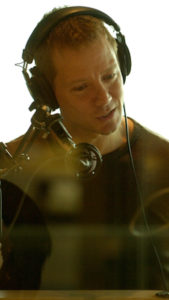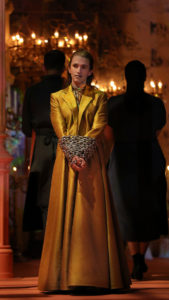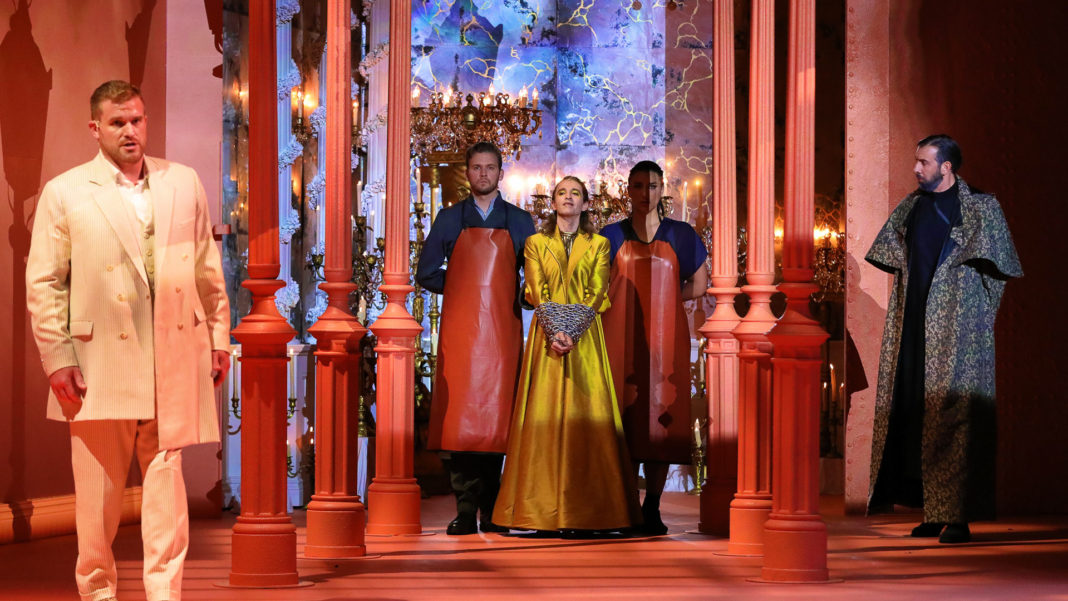
“When we talk about the twelve years,” John Corigliano says during a Zoom conversation recently, “Mark wrote the libretto twelve years ago. It took me that long to write the music. I’m a very slow composer. It took me twelve years to write this just as it did twelve years to write The Ghosts of Versailles.”
He’s talking about his new opera The Lord of Cries which is having its world premiere at Santa Fe Opera. Mark is his spouse of 26 years, librettist Mark Adamo (who is also a composer, but not on this opera.)
Corigliano is perhaps best known for his Academy Award-winning score for The Red Violin and his Symphony No. 1 written to commemorate the loss of friends due to AIDS. Adamo is the composer and librettist of the operas Little Women and The Gospel of Mary Magdalene.
The opera cleverly combines Euripides’ Bacchae with Bram Stoker’s Dracula. If that sounds like solely an intellectual exercise, it actually works well.
“It’s seemed so simple if you knew both texts,” Adamo says. “It was Alexander Neef, who was leading the company here before he was summoned to Paris, who was discussing the piece with our assistant Peggy. He said, ‘What’s it about?’ Peggy took a breath and said it was Euripides told through the characters of Stoker. He said that was brilliant.”
Corigliano adds, “In some ways the project is very hard to describe, but very easy to see. If you see the opera it all makes sense. This one is intellectually complicated, but dramatically very simple. It makes perfect sense on the stage.”

Adamo comes up with perhaps the best possible description of their opera. “In the martini of this show, the gin is Euripides and a rinse of vermouth is Stoker; a very dry martini and a little will go a long way. It’s like a Victorian staging of the Bacchae with a little swirl of the Dracula.”
You add to that recipe Corigliano’s writing and you are set according to Adamo. “Everything that John does as a composer, the surrealism, the kind of way in which he finds himself in tonal and legible and formal music that is completely depraved and surreal…if Ghosts was based on the Met, this was really written on him.”
Starring as Dionysus in The Lord of Cries is counter tenor Anthony Roth Costanzo. The role was written for him specifically because they knew the role would be set in that range.
“Once it was clear the best way of doing Dracula was going beneath the Stoker was to see what it had in common with Euripides,” offers Adamo, “the notion of the God who is disguised as a vampire in this case made sense for the characters and the story.”
“Anthony is petite, he’s not androgynous, he looks very male, but in the right costume he could be quite androgynous,” opines Corigliano. “That’s what Dionysus was and that’s what I wrote for.”

Adamo adds, “To be gender fluid is very modern, it’s very 2021, but it’s also very 455 B.C. In a certain way you just find the thread that connects the past to the present and do something interesting with it.”
At the core of The Lord of Cries is a story about repression that is as topical today as it was when Euripides first wrote Bacchae.
“It’s almost funny how many stories crop up in the news that could have been motivating this piece. Monsignor Burrill, who wanted to deny President Biden communion because he didn’t agree with his stance on certain sexual issues, had to end his career because he couldn’t tell the truth about who he is. Committing to a church who told him he shouldn’t exist. He becomes an enforcer of that. And lo, he spends the day upholding very brittlly that dogma and spends the night trolling the internet for sex. There’s not a lot you have to do to Euripides to make this contemporary.”
Corigliano summed up rather succinctly the theme of their opera. “If you are repressed and stay repressed and you don’t give into the animal urges ever, you’ll destroy yourself.”
For a composer who relied on take-out chicken, a bottle of wine and ten milligrams of valium* to get through the world premiere of The Ghosts of Versailles at the Metropolitan Opera, he’s not giving into to his own urges to be anxious while attending to the debut of The Lord of Cries in Santa Fe.
“For the first time in my life I actually enjoyed listening to this. Partly because the performances were so secure from the first rehearsal. The orchestra is top-notch. When it got on the stage for some reason I was extremely confident and I went into it without any tension at all. This is the first time in my life. It’s a whole new me.”
“I have to say what have you done to my spouse of 26 years,” Adamo jokingly adds. “This is not John.”
I suggested that it was perhaps a result of working so closely with each other.
“Maybe that’s it,” Corigliano considers. “I don’t know the answer. I’ll know when I go to another performance of my music. This is, at 83, the first time I’ve been able to relax and enjoy the performance.”
Adamo certainly hopes so. “Let’s hope you’ve outlived your life-long anxiety. That’s my story and I’m sticking with it.”
To which Corigliano responds simply, “How nice to let it go.”
This is the first in a week-long series of interviews with the artists participating in this year’s Santa Fe Opera season. Come back on Thursday for our interview with Anthony Roth Costanzo.
For tickets to The Lord of Cries, please go here. Three performances remain on August 5th, 11th and 17th.
Main photo: Jarrett Ott, Anthony Roth Costanzo, Matt Boehller and the Santa Fe Opera Chorus in The Lord of Cries (Photo by Curtis Brown/Courtesy Santa Fe Opera)
*Corigliano told me about this in a 2015 interview I did with him.











